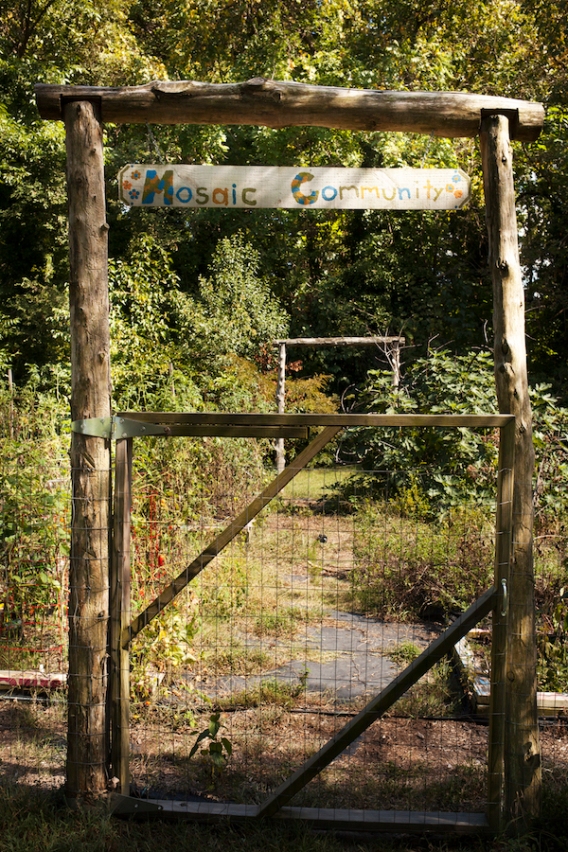
Story and photos by Lisa Sorg
Candace Mixon, her dog, Jelly, and Matthew Lynch were spending a perfect fall afternoon sipping beers at a picnic table outside Sam’s Quik Shop. (To clarify, Jelly was not drinking.) They looked young and metropolitan, like people who might know which end of the regional day pass to stick in the card slot.
It turned out they were ardent public transit fans, and using our own code, we traded observations on buses and trains in the way that regulars and commuters do.
“The 400 and the 405 used to take forever, an hour just to get to Chapel Hill.”
“It’s better now that they don’t go to New Hope Commons.”
“I take the bus to Cary.”
“Is that the 100 to the 300?”
“I sometimes take the Amtrak to Raleigh. And I used to commute to Greensboro on it.”
And so on. It’s not that they or I oppose cars—we each own one—but driving has become a drag.
“15-501, I despise driving it.” —Candace Mixon
“The roads aren’t set up for bikes, There needs to be an option besides driving.”—Matthew Lynch
Once the train leaves Buchanan Boulevard for the Ninth Street station, the rail line will be no longer run along a street but will be elevated instead. It will climb through a forest—part of which will need cut—behind the Center for Documentary Studies, swing in front of the Hillside Convalescent Center, two institutions already accustomed to trains. (In my previous coursework at CDS, audio/video recording occasionally had to stop while a train passed.) It will continue over Swift Avenue to the Ninth Street station, where people can take an elevator from the platform to the street level, right across from Sam’s Quik Stop.
(I admit I waxed nostalgic for a future chilly fall evening, sitting for a spell with a book I will have just purchased from The Regulator up on Ninth, sipping a bottle of Porter and waiting for the train to arrive. More likely though, it will be a blazing hot day in July 2025, I’ll have gulped the last of my water and be sweating it out on the platform, only for the train to be late.)

I wonder how the station’s placement south of Main Street will help or hurt the businesses up on Ninth. I also wonder how or if the train will co-exist with the Bull City Connector, the free bus that goes from Golden Belt to the medical center. The routes are similar, as is the timing—about every 17 minutes—and I could see the BCC cannibalizing the train ridership.
On one hand, the train could help alleviate some of the Ninth Street neighborhood’s parking issues. On the other, it could further buttress the Great Wall of Erwin Road, the underpass that if not for Sam’s, few would traverse. But for a six-pack of beer, people will cross a nasty intersection beneath the Durham Freeway.
The question is, will they cross that intersection for pancakes at Elmo’s Diner? (I would.) The latest issue of Mental Floss? (Ditto.) Some flowers or a tchotchke? (Double ditto.)
A lot of people will live near the Ninth Street Station. While Duke University housing encompasses most of the neighborhood south of the station—thus, precluding any significant development there—to the north, it’s a housing bonanza if you have a grand to drop on a one-bedroom. Nearly 1,500 apartments have recently been built or are in the pipeline, and that does not include all the seasoned single-family bungalows in Old West Durham.
There is still room for development, though—a Duke parking lot on Hillsborough Road, for example—and some workforce/affordable places sure would be nice for the workers at Harris Teeter or any of the Ninth Street businesses.
Here are the census figures for the block group that includes much of Old West Durham (Source: Durham Neighborhood Compass)
Total population: 1,963 Latino 15% White 69% African-American 7.6%
Median age: 28.7, which is much younger than the county average of 37
79% of residents are renters, and of those, 54% spend more than a third of their household income
on housing and housing-related costs

AngelR
Every time I hear about elevated trains or at grade crossings for new urban infrastructure, I think I’m in the stone age. These engineers nee to spend a few weeks in Spain, France and Germany. Trains that enter urban areas go underground and at grade crossings are always avoided. By having the trains underground, aside from being safer and quieter, the surface freed up becomes extremely valuable real estate that pays for part of the cost of the infrastructure.
LikeLike
many
Angelr; I agree. In Europe the trolleys (essentially buses on tracks) run at grade and especially into central squares, but trains that are passing through are well separated from other traffic.
BTW it’s not “a housing bonanza” if it costs a grand for a one-bedroom. Too much favorable verbal spin throughout this series Lisa.
LikeLike